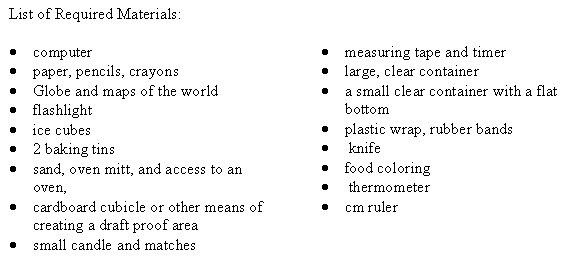Stephanie J. Sheehan
References
Abbot, Patrick.
Natural Disasters
. New York: McGraw Hill, 2004. This book explains air masses, global wind patterns, and natural disasters such as drought and floods.
Encyclopædia Britannica. “Ghana”. Encyclopædia Britannica Online, 2008. http://original.britannica.com/eb/article-55173 (accessed July 24, 2008). Provides in depth discussion of the various regions of Ghana and the weather and vegetation in each.
2008 Home Training Tools. “Home Science Tools: The Gateway to Discovery.” Home Training Tools, Ltd, 2008. http://hometrainingtools.com/articles/weather-experiments-projects (accessed April 6, 2008). This website has several weather related experiments that make the science interesting and easier to understand. The experiments can be conducted with reasonably accessible materials.
Levy, Patricia.
Cultures of the World: Ghana.
Tarrytown, New York: Marshall Cavendish Corporation, 1999. This book was created for older children and has detailed information on the culture, food and economy of Ghanaians. It would be used as a read aloud or for research with adult assistance.
Library of Congress. “Ghana.” Library of Congress Country Studies, 1994. http://lcweb2.loc.gov/cgi-bin/query/r?frd/cstdy:field(DOCID+gh0040) (accessed March 19, 2008). This website has detailed information about the geography of Ghana and the climate. It is particularly useful because it explains the climate differences among the geographic regions.
Robinson, Henry W. “Activities in Meteorology: Coriolis Effect.” National Weather Service, 2008. http://www.nws.noaa.gov/om/educ/activit/coriolis.htm (accessed on July 29, 2008) This web page describes two possible ways of demonstrating the Coriolis Effect in a classroom.
New Haven Public Schools. “New Haven Public Schools Draft Science Standards.” New Haven Public Schools, 2007. http://www.newhavenscience.org/2curroverview.htm (accessed April 6, 2008). This is the full listing of New Haven science standards.
Teacher’s Additional Resources/ Reading List
Emiliani, Cesare.
The Scientific Companion:Exploring the Physical World with Facts, Figures, and Formulas
. New York: John Wiley & Sons, 1995. Chapter 11 provides valuable background knowledge for the teacher on atmosphere, wind patterns, air masses, and weather patterns.
Owusu-Ansah, David, B.A., M.A., Ph.D.
“
Ghana.” Microsoft® Encarta® Online Encyclopedia 2008. Microsoft Corporation, 2008. http://encarta.msn.com/text_761570799__0/Ghana.htm (accessed April 8, 2008).This site is useful because it gives detailed information on the agriculture and resources of Ghana.
Scholastic
. Scholastic Atlas of Weather.
New York: Scholastic, 2004. This book would be used as a read aloud to provide background knowledge of weather forces or for research with adult assistance.
Stern, David. “(S-1B) Global Climate, Global Wind Flow.” Stern, David. http://phy6.org/stargaze/Sweather2.htm (accessed April 6, 2008) This website has advance descriptions of how wind flows in different regions of the earth, and explains the differences between weather patterns of different latitude zones.
Wikipedia, “ Library of Congress Country Studies: Ghana.”Wikipedia, 2008. http://en.wikipedia.org/wiki/Geography_of_Ghana (accessed March 19, 2008). This is a collection from the Library of Congress Country Study and has the same information, but it is easier to browse than the Library of Congress site.
Annotated Children’s Reading List
BBC Homepage. “BBC Bitesize Geography: Weather and Climate.” BBC, 2008. http://www.bbc.co.uk/schools/geobitesize/geography/weather (accessed April 6, 2008). This site for students and teachers has lots of information on weather, global weather patterns, weather measurement tools, descriptions of various climate types and other geography related weather information.
Davies, Lucile.
Countries of the World: Ghana.
Mankato, Minnesota: Bridgestone Books, 1999. This book contains a detailed summary of the people, culture and geography of Ghana, with captivating photographs throughout.
Levy, Patricia.
Cultures of the World: Ghana.
Tarrytown, New York: Marshall Cavendish Corporation, 1999. This book was created for older children and has detailed information on the culture, food and economy of Ghanaians. It would be used as a read aloud or for research with adult assistance.
Scholastic
. Scholastic Atlas of Weather.
New York: Scholastic, 2004. This book would be used as a read aloud to provide background knowledge of weather forces or for research with adult assistance.
